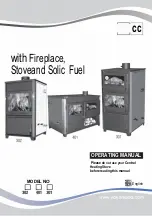
24
P61A Pellet Stove
Exposed blower wheel
and flue opening, NOTE:
ESP probe is visible.
Blower cover
removed.
ESP
probe
6. Remove the ash pan and properly dispose of the
ashes.
7. Remove combustion blower cover by turning the
blower cover latch vertical, see Fig.26. Sliding the
cover out of the slot on the left. This will expose the
combustion blower wheel and flue outlet, Fig.27.
8. Clean the combustion blower wheel with a brush and
a vacuum cleaner. Note: Do not use a household
vacuum to clean the stove. We recommend that
you use a shop vacuum that is equipped with a fine
dust filter called a HEPA filter or a vacuum specially
made for ashes and soot.
using a vacuum which is
not equipped with a fine dust filter may clog and
disperse fly ash and soot into the room.
nOte: the StOve MuSt be cOMPletelY
Out beFORe YOu vAcuuM the StOve. live
PelletS, iF Sucked intO the vAcuuM will
light the vAcuuM On FiRe And MAY ulti-
MAtelY cAuSe A hOuSe FiRe.
9. Use a brush to clean the flue, being careful not to
damage the ESP probe, see Fig. 30. The flue goes
straight through into the vent pipe (Fig.27) therefore,
the vent pipe can also be cleaned, to some extent,
through the flue outlet.
10. Reinstall the blower cover and close the latch.
11. Slide the ash pan into stove and latch the door.
Fig. 30
Fig. 31
Fig. 33
Be careful not to
damage ESP probe
when cleaning with
brush.
Soot and Fly Ash
The products of combustion will contain small
particles of fly ash which must be removed from the
inner walls of the stove and from the venting system
periodically. Removing fly ash and soot improves effi-
ciency, insures that the flue venting passageway is clear
and unobstructed. The stove should be cleaned after
each ton of pellets (50 bags) and the venting system
inspected and cleaned after each heating season.
Maintenance
Burn pot
Clean-out
plate
Latch "open "with blower
cover partly removed. Burn
pot clean-out is open.
Latch "closed "with blower
cover in place. Burn pot
clean-out is closed.
Fig. 29
Fig. 28
ESP
Probe
















































